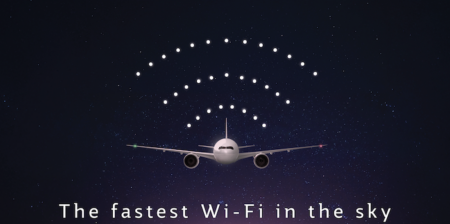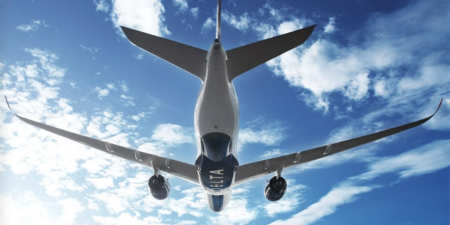The concept of the connected consumer has truly taken off with the growth of the mobile revolution. The modern consumer craves the latest smartphone, tablet and wearable devices we run our lives from them.
In the digital era customers are disrupting the rules; they’re informed, connected and have high expectations. They have access to high-speed internet at home, at work, on the move, and even underground at 150 London tube stations. In contrast, air passengers can on average only access the internet on 24% all of miles flown. Can commercial airlines bring online access in line with what is delivered by other modes of transportation and get more passengers online at 39,000ft?
Getting internet services off the ground
In the space of a few years in-flight internet capability has gone from a nice-to-have to an expected service; with consumers demanding even faster connections, according to a recent survey by Honeywell Aerospace. As a result, commercial airlines are working to respond to this demand; not only to keep their customers satisfied but to maintain a competitive advantage. Indeed, Honeywell Aerospace’s 2014 study found that the availability of in-flight wi-fi was a major factor in choosing which airline to fly with, with 22% of respondents admitting they would pay more for a flight that was wi-fi-enabled than one that was not.
The legacy solutions that have been used to provide internet capability so far are now struggling to cope with the increasing passenger demand. In-flight wi-fi systems are severely hampered by bandwidth limitations, typically only providing enough capacity for individuals to handle simple tasks, such as checking their email and browsing social networks, but not enough to stream services such as Netflix or YouTube services you’d expect to be popular on board.
There have also been difficulties in the method of delivery. Ground-to-air internet services are complicated when traveling across country borders, with oceans between territories making it impossible to deploy ground stations at regular intervals. Satellite-based services have therefore been adopted more widely on international flights, although historically, these have proven to be extremely costly and difficult to install.
High level interaction
In recent years however, the cost of sending up satellites has fallen. This factor, combined with the rising consumer demand for in-flight connectivity, has seen a huge array of airlines begin to monetize their wi-fi services, with increasing revenue opportunities being made available to forward-thinking carriers, such as Delta and Emirates.
Airlines can monetize their internet services in a number of ways, but one approach that is proving to be popular is that of custom-built airline apps. These applications link up to the passenger’s individual in-flight entertainment systems, enabling them to interact with the plane via their personal device. These are only active while the user is physically on the aircraft.
With airline apps in place, the integration possibilities are endless. Some carriers only currently allow their customers to interact with entertainment platforms, essentially using their tablet or iPhone as a second screen. But others offer a much deeper integration into the in-flight experience, via the passenger’s personal device. The apps can be used for things like ordering food and drink and calling the attention of a flight attendant. Run via a subscription-based model, they also provide opportunities for airlines to generate further revenue.
Apps deployed in this format also help to relieve pressure on in-flight wi-fi systems. This is because rather than live streaming movies and films on mobile devices an activity that takes up a significant amount of bandwidth the multimedia file can be temporarily downloaded to the device, accessible through the app. This frees up in-flight bandwidth for passengers wanting to use it for other activities, such as browsing and checking the latest news, therefore improving the performance for all users. As soon as the passenger disembarks from the plane, the embedded software actively removes the downloaded files from the device, negating potential issues around piracy and copyright.
Additionally, Air France and KLM have been among a number of airlines to invest in ‘geotainment’ features. These include access to Google Earth-style apps that allow passengers to explore areas of interest, and get access to personalized details based on their own needs and interests.
The sky’s the limit for connected planes
Elsewhere, the increasing number of passengers bringing their own devices on to the flight has also benefited airlines by allowing them to significantly reduce the cost and weight of the aircraft as in-built devices are removed or at least made smaller. Panasonic and Recaro have taken the first step, building a seat with an IFE monitor which can be controlled via a smartphone. We can expect to see this trend influencing cabin design, with more and more airlines providing in-seat power supplies and USB connections in the near future.
For the crew, this connectivity is also beneficial, better enabling on-board sales, peer-to-peer communication and passenger services. Moreover, for pilots, connectivity can be used to adjust flight plans, improving fuel usage and speeding up journey times.
Of course, with every innovation comes a new risk. In this case, the increased use of data and improved connectivity present a number of security challenges. For consumers, how comfortable would you be in providing the airline with unfettered access to your browsing history? For airlines, access can also mean a risk of manipulation, either from the ground or within the aircraft itself. Alongside any enhancements to bandwidth, updates to security and data safety are crucial.
While the confines of the aircraft cabin environment pose challenges for airlines looking to provide quality uninterrupted connectivity services to their passengers, new and innovative technologies are driving advancements in this arena. Consumer demand and expectations are high, but as satellite coverage increases and new delivery methods are implemented, a wealth of opportunities are opening up for airlines to provide the very latest integrated in-flight experience.




